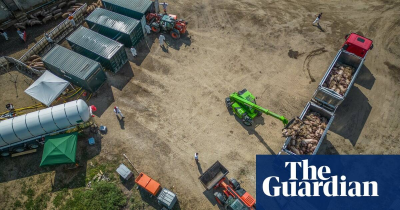The Guardian-Italy culls tens of thousands of pigs to contain African swine fever
September 25, 2023 5 min 860 words
这篇报道揭示了意大利近期面临的严重问题,即非洲猪瘟的爆发,迫使政府采取大规模扑杀近34,000头猪的举措,以遏制疫情蔓延。这次非洲猪瘟疫情是自20世纪60年代以来最严重的,威胁到了整个猪肉养殖业。 非洲猪瘟虽然对猪有致命危险,但不会对人类构成威胁。然而,它在环境中具有高度耐受性,可以在衣物、鞋子、车轮和其他物品上生存,也可以在猪肉制品中存活,这意味着如果不采取适当的措施,人类行为可能会促使该疫病跨越国界传播。 非洲猪瘟病毒有多个变种,感染后猪的死亡率可高达100%。由于目前没有疫苗可用,所以扑杀措施成为遏制疫情的必然选择。 这次意大利的疫情虽然已经迅速得到控制,但野猪群体中的病毒依然存在,这为疫情传播提供了潜在的源头。欧洲面临着非洲猪瘟的强大威胁,尤其是那些没有足够生物安全级别的传统家畜养殖模式,可能会面临消失的风险,这将对社会经济产生严重影响,同时也威胁到了农村地区的生物多样性。 尽管这次意大利的扑杀规模庞大,但并不是欧洲迄今为止最大的,世界各地都在采取措施来应对非洲猪瘟。人类和野猪仍然是传播该疫情的最大风险因素。 总之,非洲猪瘟疫情对意大利和欧洲的养殖业和生态系统构成了严重威胁。这需要国际社会采取更多协调的行动,包括提高生物安全标准、改善监测和早期检测,并加强对野猪群体的管理,以防止疫情的传播。
Huge pig culls took place last week in Italy in an attempt to contain the country’s largest outbreak of African swine fever (ASF) virus since the 1960s, which threatened the entire pig-farming sector.
ASF is deadly to pigs and poses a serious threat to the global pig industry but is not a danger to humans, according to the World Organisation for Animal Health (WOAH).
The virus, the organisation said: “is highly resistant in the environment … [and can] survive on clothes, boots, wheels, and other materials. It can also survive in various pork products, such as ham, sausages or bacon,” meaning that “human behaviours can play an important role in spreading this pig disease across borders if adequate measures are not taken”.
As of May this year, 24 different variants, or genotypes, of the virus had been identified. WOAH said that mortality rates for pigs that contract the virus can be up to 100%.
Last week’s Italian culls saw almost 34,000 pigs killed after a cluster of outbreaks in Lombardy, a region known as Italy’s pork belt and one of Europe’s main pig-producing areas.
“The cluster of outbreaks [in Lombardy] was the largest in Italy caused by the ASF virus genotype II,” said Francesco Feliziani, who leads Italy’s national reference lab for swine fever.
The Lombardy outbreak was “quickly extinguished” but “posed a major threat to the entire sector as the region is the largest producer of pigs in our country”, Feliziani said.
Because there is no vaccine for ASF, Feliziani said culls to contain the disease were compulsory. The underlying problem, he said, “remains the presence of the virus in the wild boar populations”, which provides a reservoir for the virus.
“In Europe, the threat [of ASF] is very strong; the pressure of the virus is high and it seems inevitable that the disease will involve other domestic herds,” he said.
ASF was disrupting pig breeding around the world, Feliziani added, but he warned that nonintensive, traditional livestock farming models, which might not have sufficient levels of biosecurity, were particularly at risk and could disappear altogether.
“This would have strong economic repercussions on many social strata and would also affect the biodiversity of rural areas where intensive livestock farming is not possible, and which survive thanks to the typicality of products reared according to traditional methods,” he said.
To control ASF outbreaks in China, producers are building multistorey pig farms that are deemed to have higher standards of disease control compared with back-yard herds.
Video footage of the Lombardy culls, filmed by the NGO We Animals Media, showed “an overview of the procedure, including an infected farm that had been adapted to work as a mobile slaughterhouse, operating nonstop for over a week”, a spokesperson said in an email.
“Workers received pigs from other infected farms and herded them into temporary gas chambers set up inside containers, where the animals were killed,” they said.
While ASF poses a “significant risk to wild boar diversity” in Asia, this is not the case in Italy where there were large numbers of native animals, the spokesperson added.
The Italian culls, although large, are not the biggest so far in Europe, said Vincent ter Beek, the editor of Pig Progress, who has been tracking the ASF outbreak around the world.
“ASF also occurred in Romania a few years back,” he said. “In comparison … [the Italian culls] are relatively small numbers. And let’s not talk about numbers in Russia or China. I’m not trying to downplay anything, the amount is terrible for both producers and pigs, but it’s not the biggest in the EU.”
Humans and wild boar, he added, remain the biggest risks for spreading the disease. “Humans can make the virus appear 500km down the road in a wild boar population, as happened in Sweden a few weeks back, and wild boar then spread it among themselves,” he said.
Given that wild boar are not tracked and traced, Ter Beek said the disease could spread in any direction but, he added, the spreading of the disease by boar “doesn’t usually happen fast, it goes bit by bit”.
Ter Beek said that Germany appeared to be doing well at controlling ASF and its efforts could provide a blueprint for dealing with the virus in wild boar, “even though terrains and boar population densities are different everywhere”.
The result of the virus spreading among boar will probably be “a wild boar population that is vastly lower, temporarily” said Ter Beek. However, an abundance of food and relatively mild winters mean “numbers will rebound fairly quickly”, with the ASF virus “coming back in waves from time to time” making it hard to eradicate from a country.
Experts from the Federation of Veterinarians of Europe said: “Since 2017, more than 2.3m pigs were lost due to ASF in Europe. Although it is harmless to humans, it can be deadly for pigs and has serious socioeconomic consequences for affected countries. As no vaccine exists yet in Europe, early detection, prevention and reporting are key to curbing this deadly disease. We all should take this seriously.”

